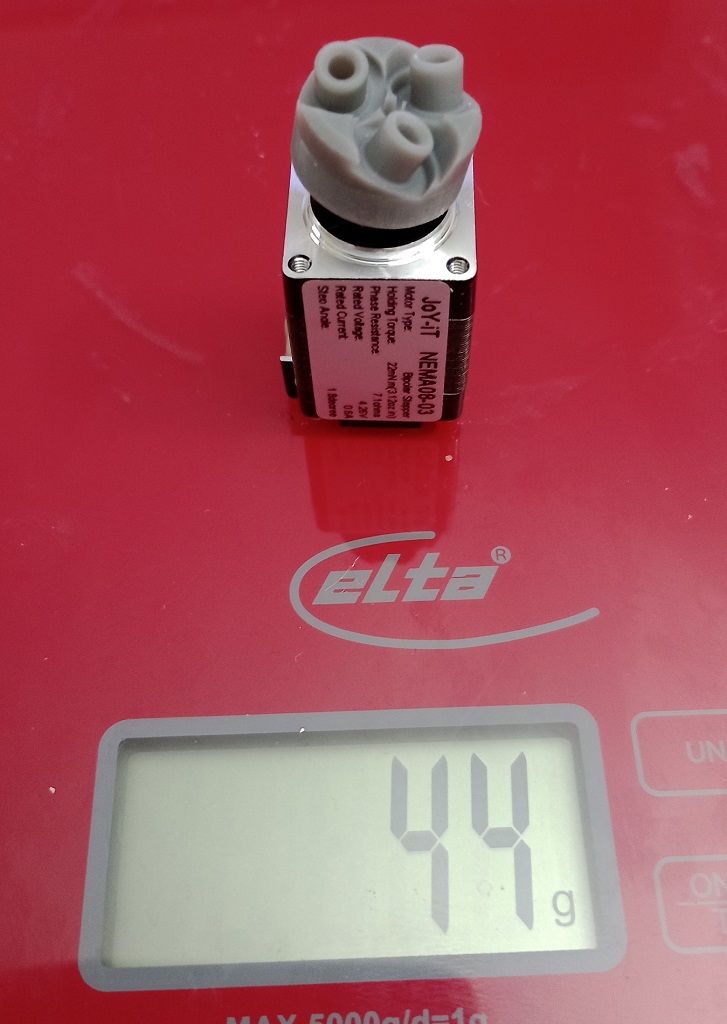Hollow shaft extruder
-
@tombrazier said in Hollow shaft extruder:
you get about 1.55mm of filament feed per rotation
That's about 2065 steps/mm for a regular stepper setup. Three times more than the 710 step/mm on the Sherpa mini and other extruders with the round NEMA14.
Maybe the stepper can be much smaller then? I have a super small NEMA08 stepper with hollow shaft. -
@tombrazier
I got two of this,
14HS14-1254H
from Stepper-Online, about 16 €, plus delivery and Tax.
It has 8 mm Shaft and 4 mm hole,
Hopefully the Power wil be OK.Gruß zero K
-
-
@tombrazier that 1.55 mm of lead is interesting. Should be more like 1.91mm. I wonder why? Are you finding that your thread pitch on the filament is staying consistent with varied speeds and loads?
-
@o_lampe That little nema8 is neat. What's that weigh?
-
@o_lampe "Haltemoment: 16 mNm" is not enough for high speed extrusion. You need to be able to drive against a back pressure which results in about 50N on the filament. I have specced a 50mNm motor from LDO.
-
@breed Theoretically it should be tan(20) * 1.75mm * pi which is about 2mm. The pitch does reduce with load but I have a design where that effect is not too bad. Nonetheless this is part of the reason. Another part is probably that the pitch diameter is less than 1.75mm because of the bite into the filament. And another is that the bearings are not perfectly tight so the cant angle is slightly reduced. That's as far as I have got with my reasoning on the subject.
-
@o_lampe said in Hollow shaft extruder:
That's about 2065 steps/mm for a regular stepper setup.
Rq3 who first pioneered the VDE-100 says he once completed a 5nm layer height print. Apparently it took a very long time but came out very smooth.
-
@zero-K As @o_lampe says, this is a much heavier stepper than needed. However it should do the job even with a 12V PSU. It will need something like 500mA to accelerate really well, by which I mean 1000mm/s^2 E feed acceleration.
I have a script that generates speed vs acceleration graphs for steppers. I'll try to post it at some point along with an explanation.
-
@breed 3mm filament takes longer to melt all the way through, and everyone wants to push print speeds faster and faster. 3mm filament is much stiffer than 1.75 so you need bigger, heavier motors to move it for most extruder designs.
I suspect we'll end up with 1mm dia filament in the not too distant future to allow the hot end to keep up with the rest of the mechanism.
-
Hi, its my first printer building myself - my first was a kit to assemble
My actuel dual print head is about 1100 g.If this new one is not as optimized in wight as yours, it´s not the end of the world for me.
Its a very nice project, I like the way filament ist moved and i can watch someting turning around and moving
It´s quite possible, if it works a little bit more as (with my skills) expected I will try to get 99%.Thank you
zero K -
@mrehorstdmd That's interesting. I wonder where the 1.75mm came from? I'm assuming 3mm was plastic welding wire originally.
-
A way to increase the filament heating surface sems to be Bondtech/MicroSwiss CTH-Nozzle und e3D high speed Revo.
No one of my friend is printing 3 mm Filament - this time has gone. -
@breed around 40grams, but it has only 1/10th of the holding torque as Tom already mentioned. It could become interesting for thinner filament or with a planetary gear

-
@zero-K It pushes the point where unmelted filament starts to clog the nozzle to a higher speed. Below that speed my experience with a CHT clone is that it actually increases back-pressure. This is not surprising because increased surface area should be expected to cause increased drag. And with the clone CHTs there is a big flat face in the middle of the 3 holes that almost blocks filament flow. Until you file it away, that is.
-
I have a moment to give the long answer now: the bearings cut a spiral groove around the filament.
Imagine that groove as a line on a thin straw shape 1.75mm in diameter. If you split the straw lengthwise and flatten it out the helix will become a series of lines sloped at 20° (or whatever the cant angle of the bearings is). The width of the flattened straw is 1.75mm x pi. Hopefully it is fairly easy to see that the vertical distance between each line is therefore tan(20) * 1.75mm * pi. Which is about 2mm.
For reasons I mentioned above you don't actually get the theoretical pitch. In practice I am presently getting about 1.55mm at "normal" printing speeds (by which I mean anything up to about 100mm/s).
-
Thank You, now ist der Groschen gefallen - can´t explain in in english.
I think, I understand it and can find the starting for the setups.Greetings
zero k -
ist der Groschen gefallen
@zero-K Curiously, the phrase translates directly into English and means the same thing. We say "the penny has dropped".
-
@breed 1.75mm comes from weed trimmer wire IIRC.
-
@oliof yep that could be. Didn't think of that.